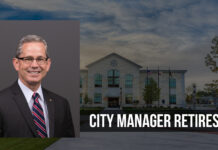The storms and subsequent flooding in southeast Texas have devastated communities from Corpus Christi to Rockport to Houston and beyond. Emergency management officials are classifying the aftermath of Hurricane Harvey as a 500-year flood event.

The short answer to the question, “What would happen to Kerrville if we received 50 inches of rain?” is that we don’t really know for sure. During some of the largest floods in modern memory, we didn’t receive that much rain. And due to our topography, where the rain falls in surrounding areas is potentially more important, as our steep terrain causes water to rush downhill toward our rivers and streams.
In the flood of 1987, the Guadalupe’s headwaters area received only 5-10 inches of rain, causing a rise of 29 feet in Comfort. And in the flood of 1978, Tropical Storm Amelia caused up to 48 inches of rain to fall in some parts of the hill country, causing the Guadalupe River to flow at around 1500x its normal rate. The 1978 flood is probably the closest we’ve come to experiencing the amount of rain that is falling now in Houston, but because the topography of the areas is so much different, we experience the aftermath much differently, too.
One of the only sources of information we have to help us predict what a catastrophic flood might look like is FEMA’s National Flood Insurance Program. The Federal Emergency Management Agency, or FEMA, is tasked with overseeing the National Flood Insurance Program, or NFIP. Within this program, participating communities are mapped for the likelihood of particular flooding events. These maps portray, at least in Kerr County, flood prone areas within a 100-year flood plain and a 500-year flood plain. Using these maps, insurance providers and the NFIP determine what folks pay for their flood insurance, and mortgage lenders determine whether or not they’ll require flood insurance. So these maps are not a guarantee of what will happen during a major flood, but they’re about the closest thing we have to a predictive model.
Contrary to popular notions, a 500-year flood doesn’t really mean that it will only happen once every 500 years. Actually, the 500-year expression is just a way to discuss the percentage chance of this type of event to build actuarial tables for flood insurance programs. So, in layman’s terms, a 500-year flood map really means, “there is a 0.2% chance of this event happening in a given year.”
So what do these maps look like for Kerrville? Our maps were redrawn in 2011 based on some new LiDAR topographic data. That is, basically a very detailed remote sensing operation was undertaken in that year, and the old maps (which were drawn back in 2001) were updated to reflect realities on the ground with higher accuracy and precision. So our current flood plain maps are dated 2011, and are available to download for free at the NFIP website.
Please note… These maps are not “guarantees” of anything! You can’t look at them and say, “oh, I’ll be fine, I’m outside the shaded area.” And on the flip side, you can’t look at them and know for sure that something will be flooded. These are based on the best data we have and the best models we have, but they’re for insurance purposes — not for emergency preparedness purposes. If you’re anywhere near a waterway, you should have plans for flooding. And as we’ve seen in Houston this week, even if you’re nowhere near a waterway, you may still be affected by flooding due to the increase in “impervious cover” in our urban areas. You may have never flooded before, but that’s no guarantee you won’t flood in the future. So, long story short… this is for informational purposes only and should not be used as a survival planning guide!
Here is an excerpt of the downtown Kerrville flood plain map.
I’ve highlighted a couple of items to take a closer look at. First, we see the light gray areas known as “ZONE X” on this map. Those are the 0.2% chance areas, aka 500-year flood. The darker gray areas are the “base flood” that has a 1% chance of happening in a year, aka the 100-year flood. The little numbers there are elevations… See 1616, 1618, etc.? That is the elevation of the base flood at that spot on the map. So if you’re building a structure, code requires that your floor be at least a foot above that elevation. And if you’re buying flood insurance for an existing structure, you get a better rate if you’re at least a foot above that elevation.
The bad thing about the FIRM maps, as pictured above, is that they’re hard to see in relation to streets, buildings, open spaces, topographic features, etc. So what they started doing in 2011 is offering this map data in a digital geographic format that can be viewed in GIS programs and Google Earth. This makes it easier to see where those flood zones are located, and this will help answer our question about the 500-year flood in Kerrville.
Downtown Kerrville
If we use this Zone X (500-year) line as our guide to what might happen in Kerrville in that type of event, here is what we see… The pink area is the “base flood” with a 1% chance. The pale blue area is the 0.2% chance (500-year event). As you can see in the image below, all of Louise Hayes park is within the base flood zone, and the entire mall and HEB south shopping center is inundated in the 500-year zone. And according to this map, most of the downtown areas north of the river would be outside both zones.
Flatrock Dam
Here’s another interesting map. Any time we place obstructions in the floodway (the river), you will see a “balloon” effect on the flood plain areas around it. Here’s the area around the Flatrock Dam in southeast Kerrville. Notice how the 500-year flood plain line balloons out to take in much of the low-lying areas in Comanche Trace.
Clearwater Paseo
Another area of the 0.2% zone that could be problematic for large residential populations is the area between Clearwater Paseo (the jail) and Loop 534. As you can see in this image, large numbers of homes are located in this area. By our count, a catastrophic flood could affect as many as 300 homes in this one area.
Quinlan Creek
In 2002, Kerrville experienced a major flood that affected the creeks and tributaries in town more than the river itself. Town Creek, Third Creek, and Quinlan Creek experienced major flooding that year, and the flooding followed a major drought. Those of us living in Kerrville during that time remember seeing cars in trees along Lytle Street, and in the aftermath, the city condemned multiple properties along those three creeks and initiated a large cleanup effort to remove impediments to flood waters.
Schreiner University is situated near the confluence of Quinlan Creek and the Guadalupe River. According to the FIRM map, the 500-year flood could inundate hundreds of homes in this area, and could also rise up into the Schreiner campus pretty significantly.
According to our maps, in Kerr County, at least 8,800 parcels of land are within or touched by the 1% or 0.2% flood zones. Again, this doesn’t mean they’d necessarily flood completely in a 500-year event, but it is something to consider and prepare for as we face a changing global climate.
Here’s the rest of Kerrville’s flood zones…

Download your area’s firm map at this address: https://msc.fema.gov/portal/search
View Kerrville’s flood plain maps using the FEMA National Flood Hazard Layers: http://fema.maps.arcgis.com/home/webmap/viewer.html?webmap=cbe088e7c8704464aa0fc34eb99e7f30&extent=-99.31147821289034,30.0025546049908,-98.97914178710955,30.100621195131826
Questions about the flood plain in Kerrville should be directed to the local Flood Plain Administrators:
And, as always, don’t take unnecessary risks during a flood! Here’s a flood safety video produced by your local government agencies:











